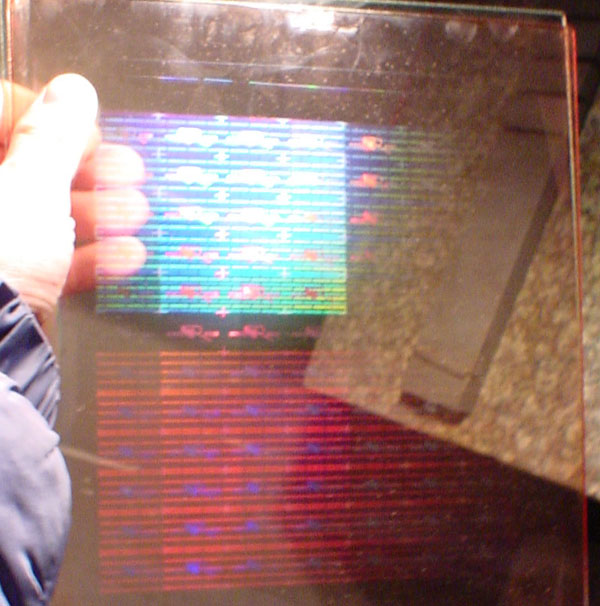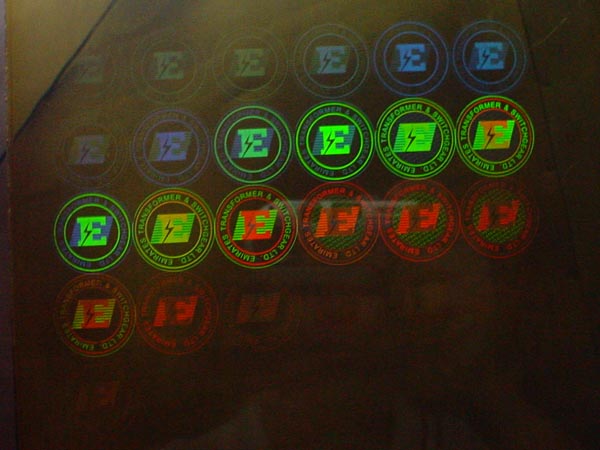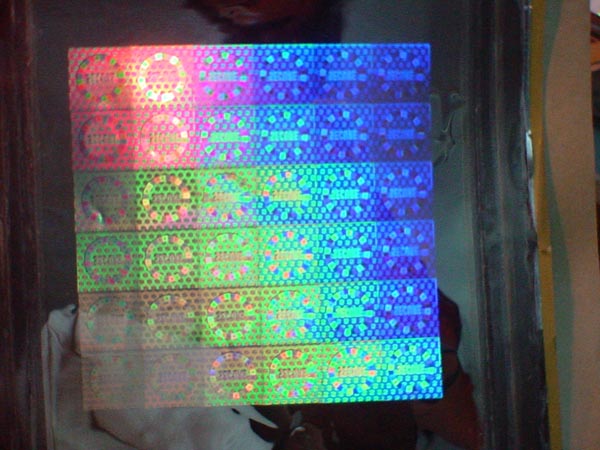DNS-IRAN Definition ; What does Hologram mean? A hologram is an image created by a photographic projection of a recording of a light field rather than an image formed by some sort of lens. It appears as a three-dimensional representation on a two-dimensional object, which can be seen without intermediate optics such as goggles or glasses. However these hologram images become unintelligible when viewed under diffused ambient light since they are not actual images. The photographic technique used to create these images is called holography.
What is a hologram or OVD and why should I use this technology?
The term ‘OVD’ (Optically Variable Device) is used to describe both laser generated hologram images and electron beam generated images.
These optically variable devices are created in highly-secure facilities and are at the forefront of overt asset and brand protection programmes.
The OVD can be used as a stand-alone feature or can be combined with printed security features to create devices that are extremely difficult to replicate using conventional photocopy or scanning technologies.
OVD technologies
The list of technologies below is by no means exhaustive. It is simply meant to act as a guide to the most frequently used OVD technologies.
2D/3D – a laser generated holographic image that has depth and parallax. It uses two dimensional artwork to build a three dimensional picture.
3D – is a laser generated image that depicts an object in 3D. It can be computer generated or created using a micro-model.
Dot Matrix – generally flat, rather than three dimensional, but highly kinetic holographic image. It can be high resolution and is ideal for containing optical forensic features such as microtext.
Filmed Stereogram – a 3D moving image created from a filmed subject. Ideal for high security work and can also be computer generated.
Combination Images – As the name suggests, a combination of some of the above single technologies in order to create an image with increased security.
Ebeam Image – this is an image created without the use of a laser. The underlying structure of the image is written at the microscopic level with an electron beam generator. This type of image can include three dimensional and highly kinetic elements with forensic features within one image. It is highly secure, but commands a high price.
Designing a hologram
From your supplied artwork (line art, colour separated or a computer file) a hologram can be chosen to suit your application. This takes into account the substrate onto which the hologram will be applied and the existing graphics with which the hologram will interact.
The design proof is usually supplied as both hard copy colour print (where the security features contained within the hologram will be detailed and shown in magnification) and as a fully animated video file that can be played on a desktop PC.
Providing your supplier offers these stages it will allow them to engineer any changes whilst the OVD is still in its design stage. The OVD is not ‘originated’ until the hard copy colour print and video file have been agreed by you. Once you have approved the inital designs, the OVD is then originated (created) and manufacturing can commence.
Registered Images, continuous images and stripes
When the OVD is designed it will be either a registered image or continuous image. You will make your choice, governed by cost, application speed, security of the image and aesthetic appearance.
A registered (specific) image can be described as a single discreet picture (image a portrait of yourself). Even though the requirement may be for millions of images, all the images will be ‘separate’ items but each is exactly the same as the next. During application, the registered image is applied in exactly the same position on each document that passes through the application press. This is the type of OVD seen on credit cards and passports.
A continuoius image is often called a wallpaper pattern. This is because the image is designed so that wherever an impression is taken, all of the elements will be included, although not necessarily in the same position as the preceeding impression. in general, continuous images are designed for cost-effectiveness rather than overall aesthetic or security concerns.
A recent development has been the introduction of the OVD stripe. Generally the stripe is an OVD continuous pattern applied at a width of 10mm or less. The benefit of strips is that application speeds are very high and thus the unit cost is lower. This makes OVD stripe application ideal for large runs. An OVD stripe can be seen on the £20 note and the Euro banknotes.
Metallised, demettalised and selectively demetallised
The embossed hologram is metallised using a vacuum deposition process. This gives the hologram its silver appearance. Lacquer coatings can be used in the production process to alter the colour of the hologram, giving gold, red, blue etc.
It is also possible to use high refractive index coatings in the metallisation process instead of aluminium. This allows the OVD to be transparent at some angles of view yet fully diffractive at other angles. This type of product is ideal for ID applications where the transparent hologram is used as a security device to protect a photograph or important data.
A further process that can significantly increase the security of the OVD is selective demettalisation. In this process metal is removed from the OVD image after metallisation. Fine detail patterns can be achieved, including micro text. This process, when allied to a high security image creates a product that would be almost impossible to copy accurately.
Carrier Medium
The OVD’s that are in general use today are created as embossed, metallised images. This is the type of OVD as seen on a bank card, cheque or bank note.
The OVD can be supplied as a pressure sensitive (self adhesive) label or as a transfer foil suitable for hot or cold stamping by rotary or platten application. The OVD images can also be supplied as a lamination film suitable for packaging applications.
In most cases, the OVD’s that can be seen on bank cards, banknotes, tickets, printed documents and cheques have been produced as hot stamping foils which are applied with high-speed precision equipment.
Hot stamping foils
Most security printers use a large volume of security hot stamping foils. They are produced to high specifications and are applied using specialist equipment onto products that are produced in their factories. They can apply registered image, continuous image and stripe as some have platen and rotary application methods. In general, hot stamping foils are used in conjuction with paper or polymer (plastic) substrates. A pre-printed material is passed through an application press at high speed and the OVD is applied onto the surface of the material. This process is used to apply OVD’s onto cheques, labels, tickets and financial documents. The application process is usually accurate to +/- 0.25mm ensuring consistency throughout the production run.
Hologram Labels
OVDs can also be supplied as labels that are tamper evident. These can be applied by hand, by hand-held applicator or by high speed labelling machines. The basic types of tamper evident labels that you can purchase exhibit their tamper evidence either by delaminating, voiding or by fracture/crumbling if an attempt is made to remove them.
Suppliers can also manufacture labels that combine security features with OVDs in order to enhance their products’ performance and to allow the end user to perform a simple test of the label. The combination of print and OVD can offer a much more aesthetically pleasing product than an OVD only label. The labels can also be indelibly numbered and the larger labels can have variable data and barcodes printed.
Applications
Cheques, Event Tickets, Gift Vouchers, Lottery Tickets, Swing Tags, Labels for tamper-evident use, Labels for Brand and Asset Protection, Taxation Documents, Parking Permits, Identity Documents, Access Control Passes.
DNS-IRAN Explanation;
Hologram refers to both the physical medium that diffracts the light to create the image and the resulting image itself. The first practical optical hologram that recorded a 3-D object was invented in 1962 by Yuri Denisyuk of the then Soviet Union and by Dennis Leith and Juris Upatnieks at the University of Michigan. Since its development in 1962, various hologram types have been developed.
One type is called a transmission hologram. These holograms are produced by splitting the laser light into an illumination beam and a reference beam. The illumination beam is projected directly on the object while the reference beam is projected directly onto the photographic medium, forming an interference pattern on the film; the result is a captured light field that was taken in a method similar to traditional photography processes.
Another type of hologram is the rainbow hologram, which is commonly used for authentication and security purposes. These are designed to be viewable under the illumination of white light rather than laser light like other types of holograms. The image is created using a vertical slit which removes vertical parallax in the resulting image, reduces spectral blur and preserves the three-dimensionality for most observers. These can usually be found on credit cards, product packaging and driver’s licenses.
Another common type is the Denisyuk hologram or reflection hologram. This type is seen in holographic displays and is capable of multicolor image reproduction.
Dns-Iran hologram administration provide completely line and running the project for all type of Hologram included security hologram , packaging , and brand protection .
so we can categorizing security hologram production step as bellow while all steps can be provided by DNS-IRAN company.
- Step one, to make record holography image onto photosensitive glass master and deliver it.
- Photosensitive Glass Master. The photosensitive glass master has holography image come our after delivering. Photosensitive Glass Master of ‘Original’ general design. It’s 2D/3D two layers. One color foreground and two color background. Photosensitive Glass Master. It’s 2D/3D three layers. One color foreground , one color background and one color floating.

- Step two, to coat silver layer onto photosensitive glass master, then the glass get current conducting. So we can put this glass into electronic forming tank to electronic form. This is silver layer coated photosensitive glass master photo of above glass master. After silvering, glass get conducting, so we can put it into electronic forming tank to make master origination. This is silver layer coated photosensitive glass master photo of above glass master. After silvering, glass get conducting, so we can put it into electronic forming tank to make master origination.

- Step three, to electronic form sivler coated glass master and get holography master origination.

Step four, to duplicate holography operation shim for embossing. The holography operation nickel shim is one mirro copy of master origination master.
































